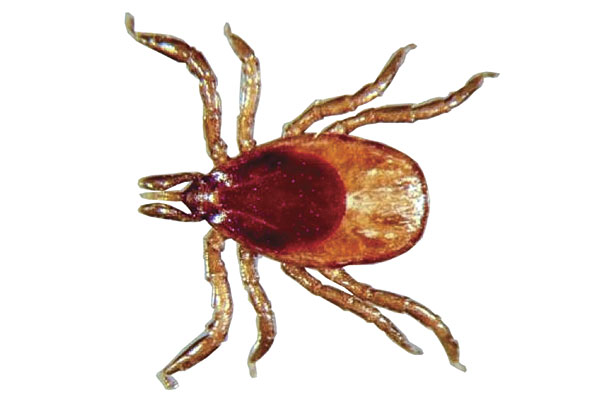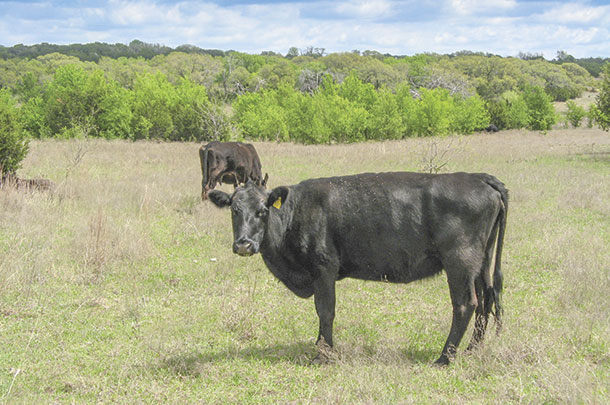In Texas and Oklahoma alone, ticks cause direct losses to marketed cows and calves at annual amounts greater than $218 million. These losses are caused by only two of several tick species that annually parasitize cattle: lone star tick and Gulf Coast tick. Money spent on control measures are added costs to losses in market values.

“Ticks are not insects, but belong to the class arachnida. Arachnids have eight legs instead of the usual six legs of insects. In addition to ticks, the class also includes spiders, scorpions, daddy longlegs and mites. Ticks are more closely related to mites than the other arachnids,” says Donald Johnson, Ph.D., extension entomology, University of Arkansas.
“Usually, ticks are not noticed on cattle unless they are worked when infested and are closely inspected,” says Pete Teel, Ph.D., and entomologist, Texas A&M AgriLife Research. “Ticks are not readily visible and require critical close-up animal inspection for level of infestation determinations, treatment effectiveness evaluations and re-treatment decisions.”
“Penning cattle for tick monitoring, however, is usually impractical, laborious and can increase stress on cattle, as well as cause more wear on facilities and subject people to injury.”
Future technology
“Future technology may improve tick detection and integrated tick management (ITM) decisions with minimal to no need to gather and inspect cattle,” Teel continues. “Our research is showing that tick infestations create chemical changes in bovine feces detectable by near-infrared reflectance spectroscopy (NIRS).”
Reflectance spectroscopy is the use of a spectroscope to measure wave lengths of energy reflected from objects of interest. Energy reflected from different substances at different wave lengths provides distinguishing characteristics. Infrared reflectance spectroscopy measures wave lengths within the infrared spectrum of electromagnetic energy.
Infrared has longer wave lengths than visible light, but shorter than radio waves. The infrared spectrum is divided into three bands for benefit of discussion. Near-infrared wave lengths range from 0.78 to 2.50 microns, mid-infrared from 2.50 to 40.0 microns and far-infrared wave lengths range from 40.0 to 1,000 microns.
NIRS is used in many industries as an analytical technique. In agriculture, it is a tool for analyzing forage quality and composition, bacteria in water, fecal nitrogen and phosphorus, carotenoids in maize, sugars in grapes and other fruits, and for many other tasks. Methods of using NIRS for analyses of fecal material to determine animal nutritional needs have been available for several years.
“Feces consist of a variety of metabolic end products,” says Douglas Tolleson, Ph.D., Texas A&M AgriLife Research. “Fecal chemistry is clearly affected by diet, but it is also affected by disease, infection and stress. If tick infestation is stressful to the host, it seems logical that fecal chemistry can reveal a quantifiable effect of the parasitism.”

“It is feasible that fecal analysis can serve as a good method to monitor ticks in grazing livestock, as long as it is possible to detect chemistry changes rapidly and accurately.”
“One of the physiological changes in an animal caused by stress is decreased production of insulin-like growth factor 1 (IGF-1), a naturally occurring protein hormone. IGF-1 is measured in blood plasma, and in addition to changes in fecal samples caused by ticks, low amounts of IGFD-1 could be one of the indicators or markers for the degree of tick infestation. Texas A&M research is looking into the relationship between metabolic indicators of stress and noninvasive methods to detect them, such as fecal NIRS analysis,” says Tolleson.
Stress in cattle also reduces roughage intake, which offers additional opportunities to detect tick infestations through fecal analysis. In one of the field trials conducted by Tolleson, Teel and others, 28 growing beef steers were assigned to one of four treatments.
Tick-infested animals and noninfested were fed either a low nutritional diet or moderate. The low-nutrition diet contained 7 percent crude protein (CP) and 58 percent total digestible nutrients (TDN), whereas the moderate-nutrition diet contained 14 percent CP and 60 percent TDN. The rations were fed 35 days prior to tick infestation through 21 days post-infestation. Three hundred pairs of lone star ticks were placed on each steer for the infested treatments.
Fecal samples were collected daily during the study and frozen for analysis. One of the results from the analyses was that within the same diet composition and level of nutrition, fecal dry matter (DM) and organic matter (OM) were greater in noninfested steers than in infested animals. This is probably a result of less roughage digestion by tick-infested cattle.
Fecal DM and OM were similarly affected by plane of nutrition and tick infestation. Results of this study and others indicate that DM and OM content in fecal material offer additional potential markers for identifying tick infestations on cattle.
“Laboratory trials show consistently detectable differences in fecal composition from cattle infested with lone star, Gulf Coast or winter ticks than from noninfested cattle. Field trials to date show detectable differences in fecal chemistry analysis before and after acaricide treatments. The differences are due to tick infestation decline,” says Teel. “Continuous monitoring of fecal chemistry provided indicators of tick re-infestation. These indicators suggest that this technology could be used for evaluating acaricide effectiveness and for making decisions on re-treatment timing.”
What’s next
Research to date shows that fecal sampling for detecting tick infestations is a promising concept, but many questions remain. Additional work is needed to clearly quantify the reliability of data under varying conditions. Are there possibly other reliable analytical markers that could further improve detection?
“We need to know more about effective sampling,” says Teel. “What is the optimal age of the manure pat for sampling? What is the best procedure for sampling manure pats in pastures? How many pats should be sampled and when? Do environmental conditions affect sample quality?”
The primary question is whether fecal sampling for ITM can become a cost-efficient and reasonable approach for producers. An economic analysis is needed to determine tick threshold for treatment under different conditions. A possible integration of fecal sampling for ticks with other bovine manure-testing profiles, such as diet quality, might provide producers with multiple guides for decisions.
“The ultimate goal of the project is to develop sensing technology that provides pasture-based, real-time tick assessments from an app on a smartphone,” says Teel. “The technology would greatly enhance integrated tick management.” ![]()
PHOTO 1: he only reliable way to identify tick infestations is to closely examine the underside of cattle while they are restrained.
PHOTO 2: The deer tick, also known as the black-legged tick, primarily feeds on deer. It can feed on other large animal hosts such as cattle and humans.
PHOTO 3: Tick infestations are not noticeable on cattle in the pasture unless they have caused scabbing or open wounds. Photos provided by Robert Fears.
Robert Fears is a freelance writer based in Georgetown, Texas. Email Robert Fears.






